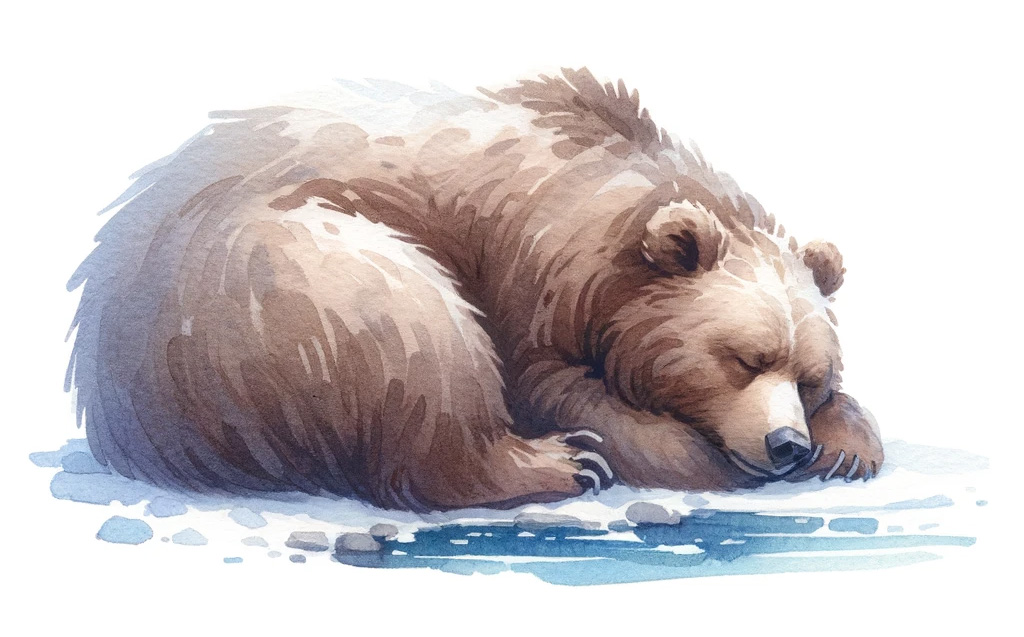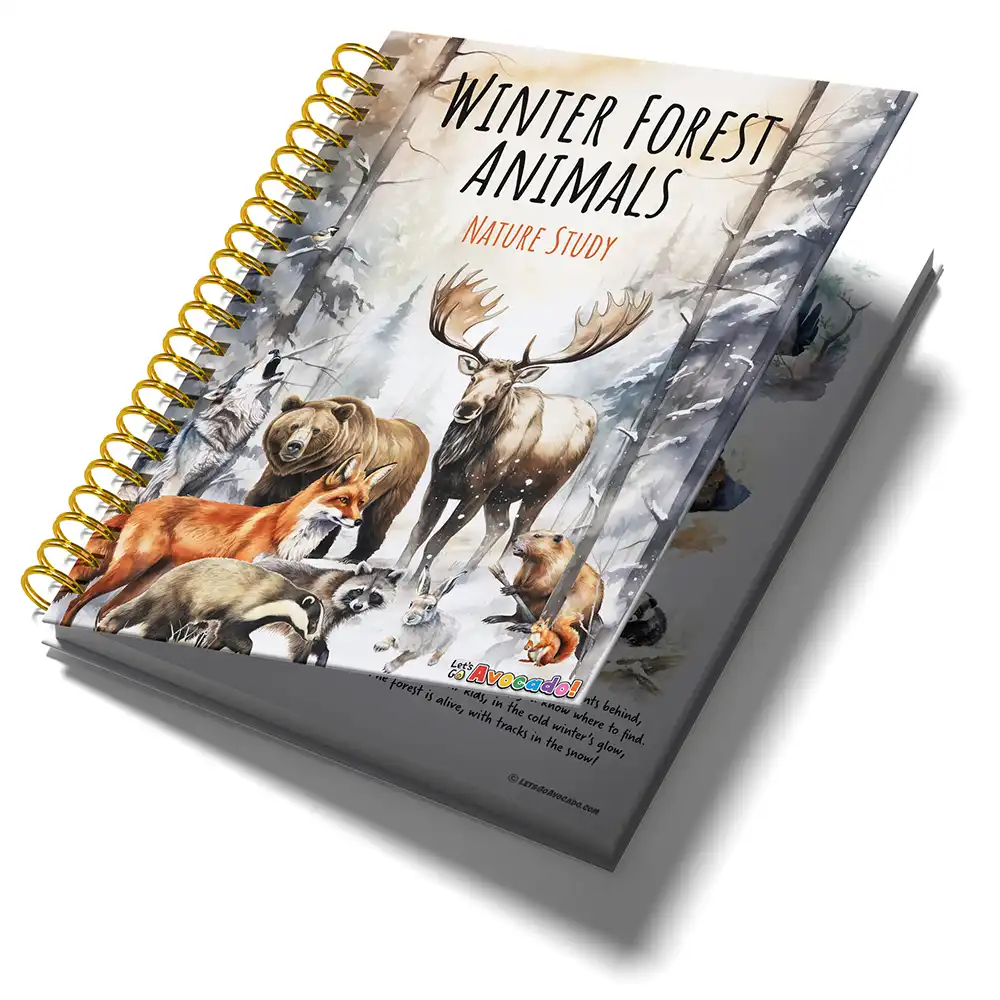This page may contain affiliate links.
Read our disclosure and privacy policy here.
Welcome to the amazing world of winter survival, where animals use clever strategies to make it through the cold months! Just like we bundle up in coats and hats, animals have their own special ways to stay safe and warm. We’re going to explore how different animals like Canada geese, brown bears, chickadees, moose, squirrels, and wolves each have their unique approach to surviving winter. We’ll see how some, like the Canada geese, fly long distances to warmer places, while others, like brown bears, take a long winter nap called hibernationHibernation is a remarkable survival strategy used by some animals to endure harsh winter conditions. During hibernation, these animals enter a deep, prolonged state of reduced activity, characterized by a significant drop in metabolic processes, including heart rate and body temperature, allowing them to conserve energy and survive through the challenging cold months. Learn More. Did you know that tiny chickadees enter a light hibernation called torporTorpor is a temporary state of reduced metabolic activity and lowered body temperature that some animals enter to conserve energy, typically during periods of cold or food scarcity. It allows these animals to become less active and save vital resources until conditions improve. Learn More to save energy? And let’s not forget how moose adapt to the cold, or how squirrels cleverly store food for the winter. Plus, we’ll learn about how wolves work together to face winter’s challenges. Get ready. Let’s Go Avocado!
Table of Contents
6 Amazing Winter Survival Strategies For Animals
Migration - The Canada Goose
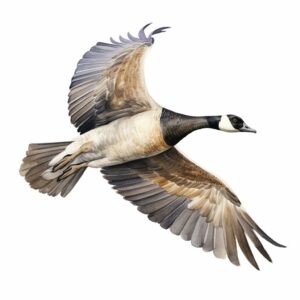
MigrationMigration is the regular movement of animals from one place to another, often to find food or better weather. It’s a seasonal trip that many animals take for survival. Learn More is a super smart way that some animals, like Canada geese, deal with winter. When the weather starts getting colder and food becomes hard to find, Canada geese don’t just stay and shiver – they go on a long journey to warmer places! They fly in a V-shaped formation, which is really cool because it helps save energy and lets them travel long distances without getting too tired. These geese can travel thousands of miles to find places where they can still find food, like lakes or fields that aren’t frozen. It’s like they have their own winter vacation! What’s really interesting is how they know where to go. Canada geese use the sun, stars, and even Earth’s magnetic field to navigate, kind of like using nature’s GPS. In the spring, when the weather gets warm again, they fly all the way back to their summer homes. Migration is an amazing journey that shows just how clever and tough these birds are!
Many animals employ strategies similar to Canada geese, migrating to warmer areas during the winter months. Here’s a list of 10 other popular and common animals that also migrate to survive the winter:
- Monarch Butterfly: Known for their epic journey from North America to Mexico.
- Arctic Tern: Holds the record for the longest migration, traveling from the Arctic to the Antarctic.
- American Robin: Flies south to find warmer climates during winter.
- Gray Whale: Migrates to warmer waters for breeding, traveling between the Arctic and Mexico.
- Hummingbirds: Many species migrate to Central America or southern United States for the winter.
- Barn Swallow: Travels from North American fields to warmer South American climates.
- Caribou: Known for long-distance migrations in North America, moving to milder areas in winter.
- Sandhill Crane: Migrates to the southern United States and Mexico for the winter.
- Osprey: A fish-eating bird that travels south to Central and South America.
- White Stork: Migrates from Europe to Africa, crossing the Mediterranean and the Sahara.
These migrations are vital for the survival of these species, allowing them to escape harsh winter conditions and find food in more temperateTemperate refers to a climate that’s not too hot and not too cold, with moderate rainfall and distinct seasons like spring, summer, fall, and winter. You’ll find temperate areas in parts of North America, Europe, and Asia. It’s the kind of climate where you can see a wide variety of plants and animals, including deciduous trees that lose their leaves in the fall. Learn More regions.
Hibernation - The Grizzly Bear, a.k.a. Brown Bear
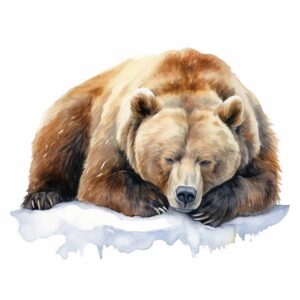
Hibernation is an incredible way that some animals, like the brown bear, also known as the grizzly bear, get through the cold winter months. As the days get shorter and the air gets chillier, these bears start eating a lot more food to bulk up. They need to gain a lot of weight because they’re going to spend the whole winter asleep, not eating at all! When it’s time, they find or make a cozy den, often in a cave or under a pile of fallen branches, and then they settle in for a long winter’s nap. During hibernation, their heart rate slows down, and they use very little energy. They live off the fat they stored from all that eating before winter. This deep sleep helps them conserve energy when food is scarce and the weather is freezing. Then, when the snow melts and spring comes back, the bears wake up, ready to start the year with new adventures. Hibernation is a fantastic survival trick that helps brown bears stay safe and snug until warmer days return.
Like brown bears, several animals survive winter through hibernation, a deep sleep that helps them conserve energy during the colder months when food is scarce. Here are 10 animals that also hibernate:
- American Black Bear: Similar to brown bears, they hibernate in dens to escape the cold and food scarcity.
- Woodchuck (Groundhog): Known for its deep hibernation, often in burrows underground.
- Hedgehogs: Hibernate in nests of leaves or logs, significantly reducing their body temperature.
- Bats: Many species of bats hibernate in caves or tree hollows, surviving on fat reserves.
- Box Turtles: Hibernate in the mud at the bottom of ponds or in hollow logs.
- Chipmunks: Hibernate in burrows, periodically waking to eat stored food.
- Garter Snakes: Hibernate in large groups in dens to maintain body temperature.
- Frogs and Toads: Some species hibernate buried in mud or under leaf litter.
- European Dormouse: Known for its long hibernation periods in tree holes or burrows.
- Prairie Dogs: Hibernate in underground burrows to avoid the cold surface temperatures.
Hibernation is an essential survival strategy for these animals, allowing them to reduce their energy needs and make it through winter when food is hard to find.
Torpor - The Black Capped Chickadee
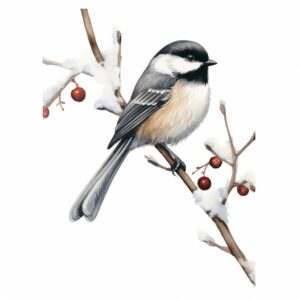
The black-capped chickadee, a tiny and energetic bird, has a remarkable winter survival strategy known as torpor. Unlike hibernation, where animals sleep for months, torpor is like taking short, deep naps to save energy when it’s really cold. During the night, the chickadee’s body temperature drops a little, and it enters a state of torpor, slowing down its heart rate and breathing. This means it uses less energy, which is super important because finding food in winter can be tough. When morning comes, the chickadee ‘wakes up’ from torpor, ready to flit around and look for food. These birds are experts at finding seeds and tiny insects, even in the snow. A cool fact about chickadees is that they remember where they hide food, which helps them when it’s cold and the ground is covered in snow. Torpor is an amazing way for these little birds to brave the winter, showing that even the smallest creatures have smart ways to cope with the cold!
Several animals, like the black-capped chickadee, use torpor as a strategy to survive winter. Torpor is a state of reduced metabolicMetabolism refers to all the chemical processes that occur within an organism to maintain life. It involves the conversion of food into energy, the building and repair of tissues, and the elimination of waste products from the body. Learn More rate and body temperature, allowing animals to save energy during cold periods. Here are 10 animals that also use torpor:
- Hummingbirds: Many species, especially those in colder climates, enter torpor at night to conserve energy.
- Bats: Some bat species use daily torpor during winter to cope with reduced food availability.
- Poorwills: The first bird species known to go into torpor, can stay in this state for weeks.
- Garden Dormice: They use torpor intermittently throughout the colder months.
- Pygmy Possums: These tiny mammals use torpor to survive cold spells in their Australian habitats.
- Swallows: Some swallow species enter torpor during cold nights or when food is scarce.
- Nighthawks: Known to use torpor on cold nights or during bad weather.
- Mouse Lemurs: These small primates use torpor, especially during the dry season in Madagascar.
- Hedge Sparrows (Dunnocks): May use torpor in extremely cold conditions to conserve energy.
- Bees: Some bee species enter a torpor-like state during cold periods to conserve energy.
Torpor allows these animals to significantly lower their energy needs, which is crucial for survival during times when food resources are limited.
Adaptation - The Moose
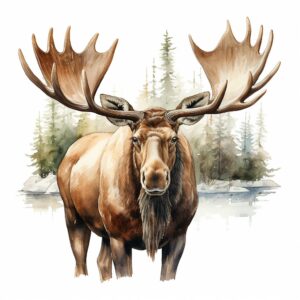
Moose, those tall and majestic animals of the forest, have some pretty neat adaptations to survive the chilly winter months. Unlike birds that fly south or bears that hibernate, moose stick around and face the cold head-on. They have thick, furry coats that grow even denser in the winter, providing superb insulation against freezing temperatures. Plus, their long legs are not just for looking impressive; they help the moose wade through deep snow to find food. Speaking of food, moose adapt their diet in winter. Since they can’t find their favorite snacks like fresh leaves and shrubs, they switch to munching on twigs, bark, and pine cones. Another cool thing about moose is their large hooves, which act almost like built-in snowshoes, distributing their weight and stopping them from sinking into the snow. These winter adaptations help the moose not just survive, but thrive in the snowy landscape, proving that being big and tough can be an excellent strategy to beat the winter chill!
Several animals, like the moose, have adapted to survive the harsh conditions of winter without migrating or hibernating. These adaptations may include changes in fur, diet, and behavior. Here are 10 animals that adapt to winter in a manner similar to moose:
- Elk: Develop thicker coats and migrate to lower elevations for better food access in winter.
- Snowshoe Hare: Changes fur color to white for camouflage in the snow and has large feet for moving in deep snow.
- Bison: Grow thicker, insulating fur and use their large heads to move snow and find grass to eat.
- Lynx: Develop thick fur and wide, furry feet that act like snowshoes for easier travel in deep snow.
- Wolverine: Known for their thick fur that resists frost and ability to travel long distances in search of food.
- Arctic Fox: Changes fur color to white and grows a thicker coat for insulation.
- Red Fox: Adapts by growing a thicker coat and changes hunting strategies to catch prey under the snow.
- White-tailed Deer: Grow thicker coats and group together in winter yards for better food sources and protection.
- Caribou (Reindeer): Their fur traps air for insulation, and they use large hooves to dig through snow to find food.
- Mountain Goat: Develop thick woolly coats and move to lower elevations with less snow for feeding.
These animals have evolved specific traits and behaviors to efficiently cope with the cold, snow, and ice, enabling them to find food and shelter, and maintain their body heat during the winter months.
Food Caching - The Squirrel
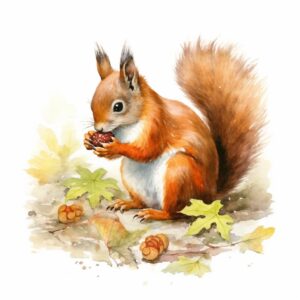
Squirrels have a clever trick for getting through the winter: food caching, which is like creating their own grocery stores in the forest! Before winter arrives, these energetic critters get super busy collecting food like nuts, seeds, and acorns. But instead of eating it all right away, they hide it in different places, like under leaves, in tree holes, or even buried in the ground. This is their way of saving food for later when it’s cold and there’s not much to eat.
During winter, squirrels use their amazing memory to find and dig up the food they’ve hidden. It’s like they have a map in their mind of all the spots they’ve stored snacks! This helps them have enough to eat when food is scarce. A fun fact about squirrels is that sometimes they forget where they’ve hidden some of their food, and those forgotten nuts and seeds can grow into new trees. So, in a way, squirrels help plant trees without even knowing it! Food caching is a smart survival strategy that keeps these playful animals fed all winter long.
Similar to squirrels, several animals use food caching, a strategy of storing food for later use, to survive through the winter. This behavior helps them maintain a steady food supply when resources become scarce due to snow and cold weather. Here are 10 animals that also use food caching:
- Foxes: Both red and gray foxes cacheA collection of items stored in a hidden or inaccessible place. Beavers cache food like twigs and branches underwater for use in winter. Learn More surplus food, such as small mammals and birds, to eat later.
- Jays and Crows: These intelligent birds hide seeds and nuts in various locations and remember where they’ve stored them.
- Chipmunks: Store seeds, nuts, and other food items in their burrows and underground caches.
- Mice: Field mice and house mice cache grains and seeds in hidden spots.
- Woodpeckers: Store nuts and insects in tree bark crevices for winter consumption.
- Nuthatches: Hide seeds and insects under tree bark and return to these spots when food is scarce.
- Raccoons: Known to stash food in multiple locations, especially near their dens.
- Hamsters: Collect and store food in their burrows and cheek pouches for the winter.
- Beavers: Create underwater food caches near their lodges, usually consisting of branches and logs.
- Kangaroo Rats: Desert dwellers that cache seeds in their burrows to survive dry conditions, similar to winter scarcity.
Food caching is an effective survival strategy that helps these animals ensure they have enough to eat during the lean winter months, demonstrating remarkable foresight and memory skills.
Teamwork - The Grey Wolf
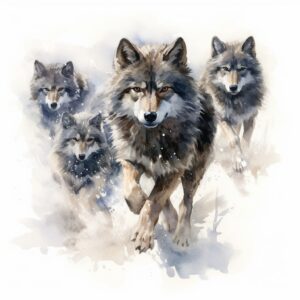
The grey wolf, a magnificent and intelligent animal, has a special way of making it through winter: teamwork! Unlike some animals that go solo when it gets cold, wolves stick together in packs. This teamwork is key to their survival. In the winter, food can be harder to find, so the wolves work together to hunt. They use smart strategies, like surrounding their prey or taking turns chasing it, making it easier to catch larger animals like deer or elk.
Being in a pack also helps keep them warm. On really cold nights, wolves will huddle close together, sharing body heat. It’s like having a furry, warm blanket made of your friends! Plus, living in a pack means there are always wolves looking out for danger, keeping the group safe.
A cool fact about wolf packs is that they’re like families with a strong bond. There’s usually an alpha pair, kind of like the mom and dad, who lead the pack. Teamwork helps grey wolves not just survive, but thrive in the winter forest, showing the power of working together.
Teamwork is a key survival strategy for many animals, similar to how grey wolves work together during winter. These animals collaborate for hunting, protection, or staying warm, enhancing their chances of making it through the challenging winter months. Here are 10 animals that use teamwork:
- Lions: In prides, lions work together to hunt and protect their young, especially important during harsher conditions.
- Elephants: They form close-knit family groups, helping each other find food and water, and protect calves from predators.
- Dolphins: Travel in pods and cooperate in hunting and defense, crucial for surviving in colder ocean waters.
- Chimpanzees: Live in social groups, sharing food resources and cooperating in hunting and foraging.
- Orcas (Killer Whales): Hunt in pods, using complex strategies to catch fish or seals, even in icy waters.
- African Wild Dogs: Hunt in packs and are known for their highly cooperative and strategic hunting techniques.
- Canadian Geese: Fly in V-formation, which conserves energy and allows for better communication during their long migratory journeys.
- Meerkats: Live in groups and take turns being lookouts for predators while others forage or rest.
- Ants: Collaborate in building nests, foraging, and keeping the colony warm and fed during winter.
- Penguins: Huddle together for warmth, especially in Antarctica, rotating positions to ensure everyone stays warm.
These examples show how teamwork and social cooperation are vital for survival in the animal kingdom, particularly during the challenging winter months when resources are scarce and environmental conditions are harsh.

There’s a lot to explore right where we are, in our own neighborhoods and backyards! Join us while we get off the couch and explore the everyday wonders of nature, science, space, engineering, art, and anything else we stumble upon during on our adventures.


